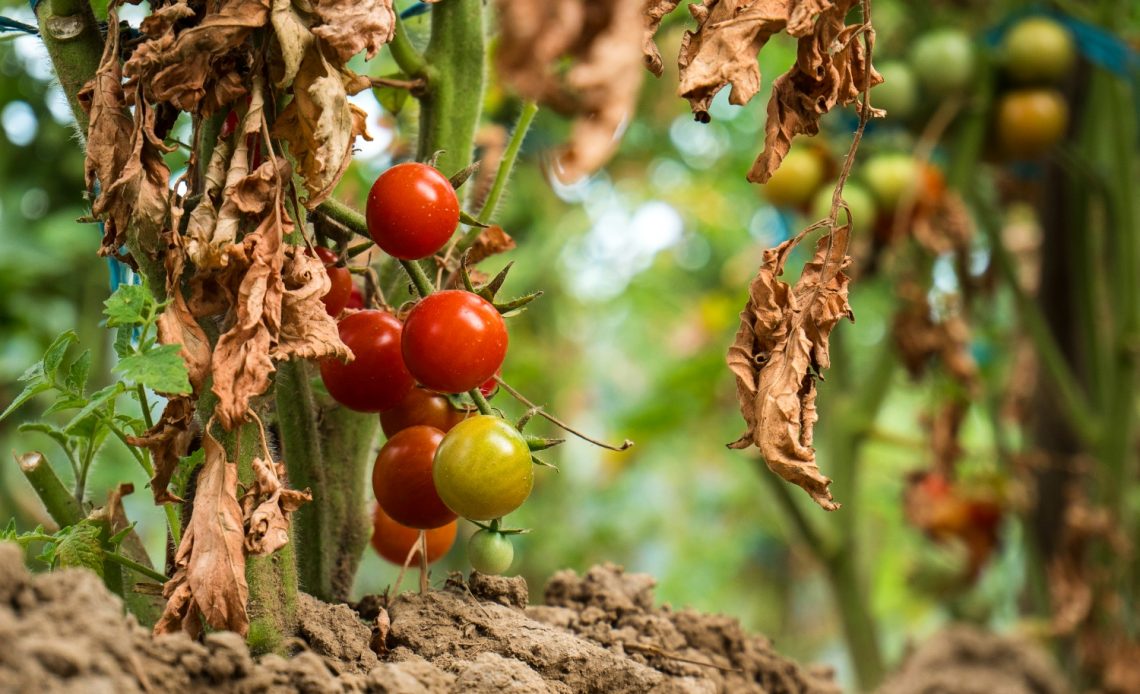

We’re here to help! Wild Yards is a completely free website that is 100% dedicated to helping you create a wildlife-friendly, sustainable yard. Read more
WildYards is reader-supported. When you buy a product through a link on our site, we may earn a comission. Every product is independently selected by our (obsessive) editors and our reviews are unbiased and objective. Read more about our mission or our privacy policy.
Tomatoes are a favorite amongst backyard gardeners because they’re a high-yield crop that’s pretty easy to grow.
With dozens of varieties to choose from, ranging from classic red and orange varieties to green, white, and black cultivars, there’s a tomato to suit every taste palette.
But tomatoes come with their own set of problems.
If you stepped out into your garden recently and noticed your tomato leaves turning brown, you’re probably wondering what’s going on, and what you can do to help the plants recover.
Tomato leaves may turn brown because the plants are getting too hot or need a deep, soaking watering. Brown tomato leaves can also signal nutritional deficiencies and diseases.
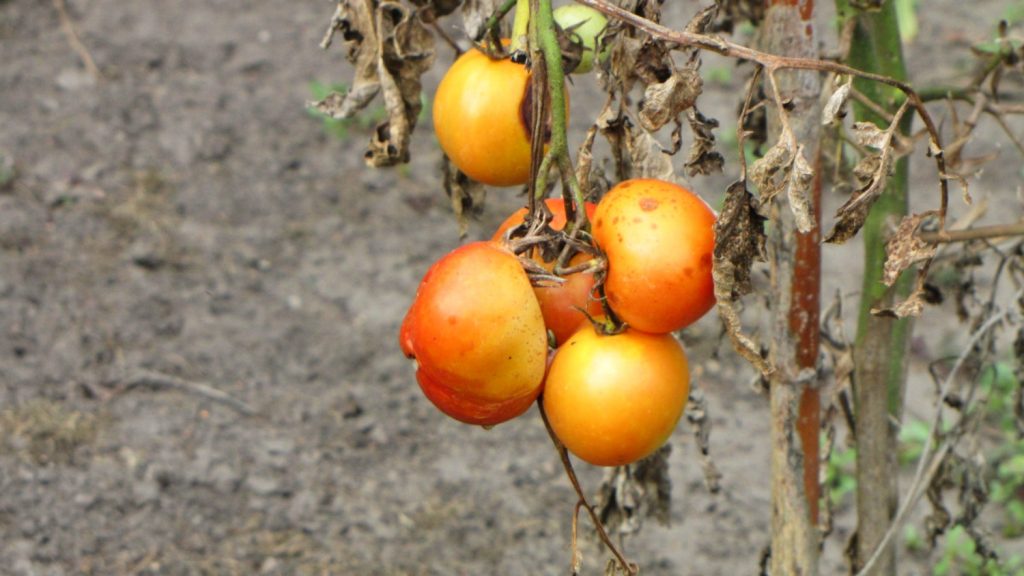
7 Reasons why your tomato leaves are turning brown, plus solutions that actually work
If you’ve noticed your tomato leaves turning brown, don’t panic. Tomatoes are hardy plants that can survive a lot of trauma.
That said, you’ll still need to help your plants out by identifying the cause of the discolored foliage and treating it quickly.
The faster you treat your plants, the better their chances of recovery.
Here are 7 of the most common reasons why tomato leaves turn brown, plus what you can do to help the plants rebound so they can keep producing tasty fruits.
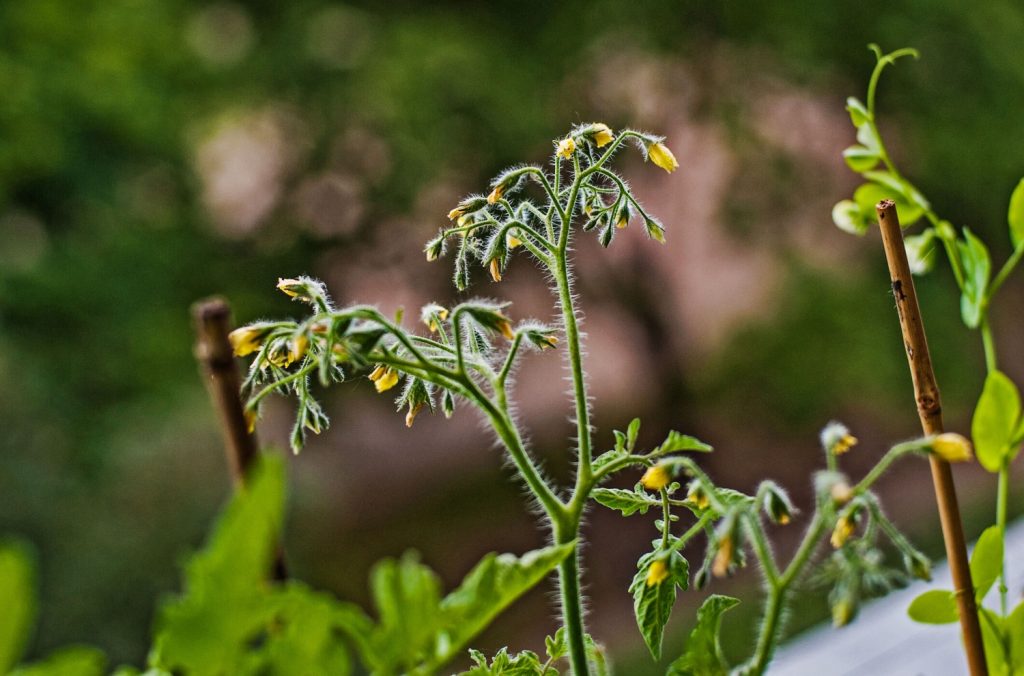
The problem: Too much sunlight
Tomatoes are sun-loving plants. Most, if not all, tomato varieties prefer to be planted in full sunlight. This way, they can get all of the energy they need to grow well.
But, as much as they love sunlight, tomato plants can still get overheated. Especially if you live in a warm climate.
If the temperatures are reaching 95+ degrees Fahrenheit on a daily basis, then that’s probably why your tomato leaves are turning brown.
Take a look around at the other plants in your lawn and garden. If you see the same pattern of leaf browning in your other plants, that’s a good sign that excessive heat is getting to your tomato plants.
Tomato plants can stay greener much longer in warm climates if the humidity is high. The extra moisture in the air keeps the plant’s leaves moist and prevents them from losing water.
But in dry climates, it’s not unusual for tomato plants to start turning brown once the temperature starts climbing.
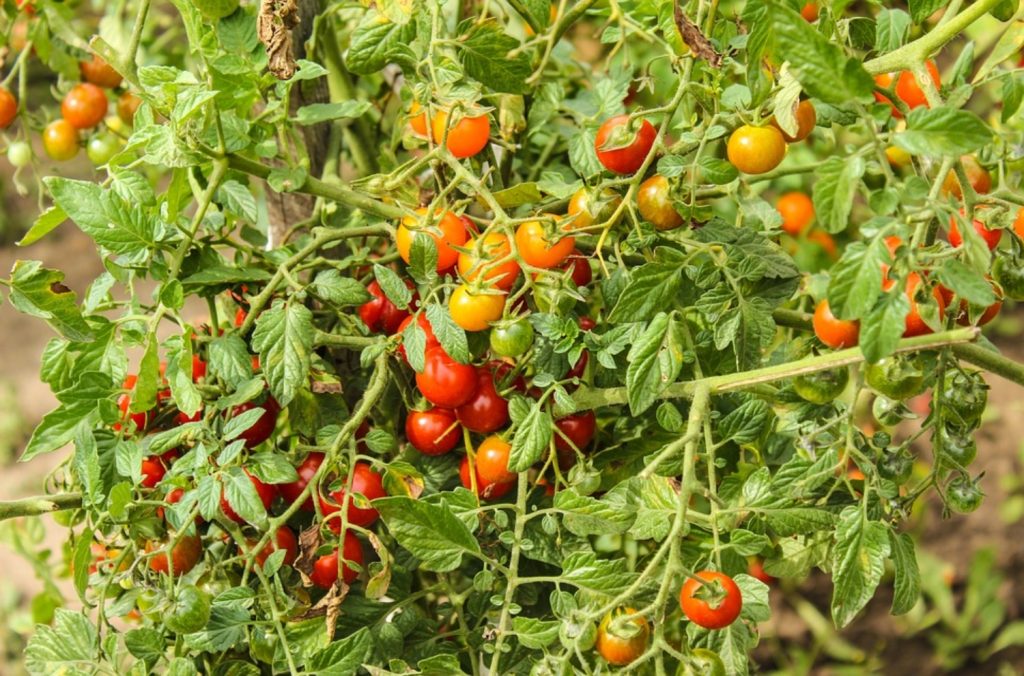
The solution: Help the plants cool down
To help keep your tomato plants cool, start by giving them a thorough watering to reach their deepest roots.
Then, immediately spread a 3” to 4” layer of organic mulch. Straw and wood chips work well, but sphagnum moss is also a good choice because it’s slightly acidic, and tomatoes like acidity.
Not only does mulch help the soil retain extra moisture, but it also insulates the soil, creating a barrier between your plant’s roots and the scorching heat of the sun.
Once the mulch is applied, you’ll need to check the soil often and water the plants again when it dries out. Move the mulch back and feel the soil with your finger at a depth of about an inch.
Regular watering and a dense layer of mulch won’t make those brown leaves turn green again. But the new leaves your tomatoes produce should be vibrant green and healthy.
If you know your climate gets hot and dry in the summertime, plan ahead by growing your tomatoes on the shady side of a tall plant, like corn, or vining veggies growing up a trellis.
This will help keep your tomatoes cool and provide them with some extra protection from the elements.
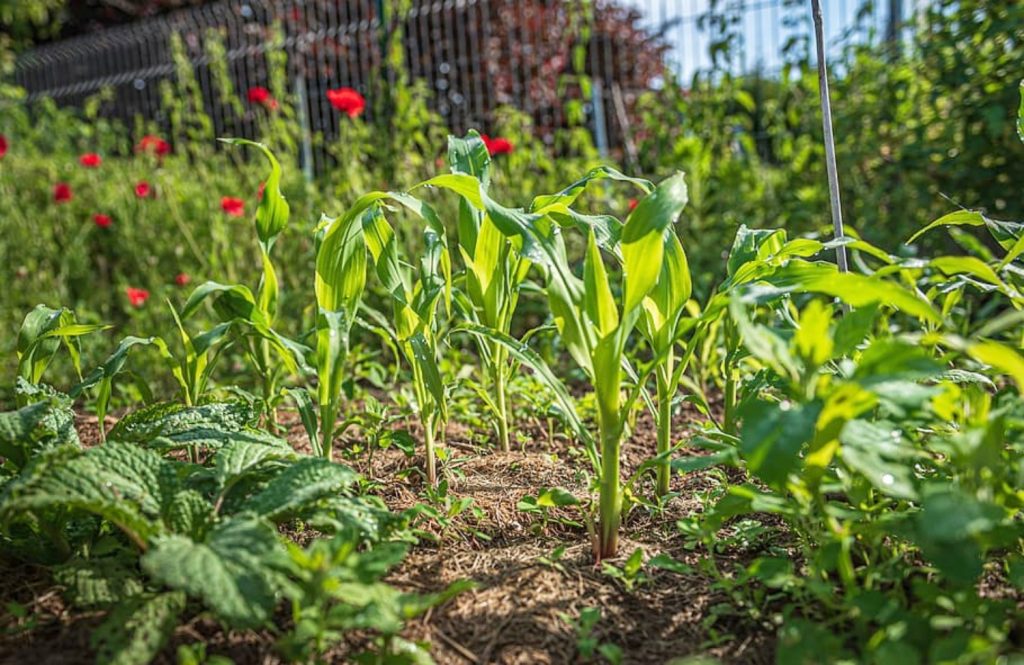
The problem: Underwatering
Tomato plants grow like weeds. If the branches are allowed to touch the ground, they can actually take root and start new plants!
But, hardy as they are, tomato plants can still suffer if they don’t get enough water.
If you find your tomato leaves turning brown, take a look at the soil.
Stick your finger into the ground an inch or two beneath the surface. If the soil feels powdery and dry, that’s a good sign your tomatoes aren’t getting enough water.
Tomato plants need an inch of water per week on average. But they may need much more than that if the climate is particularly hot and dry.
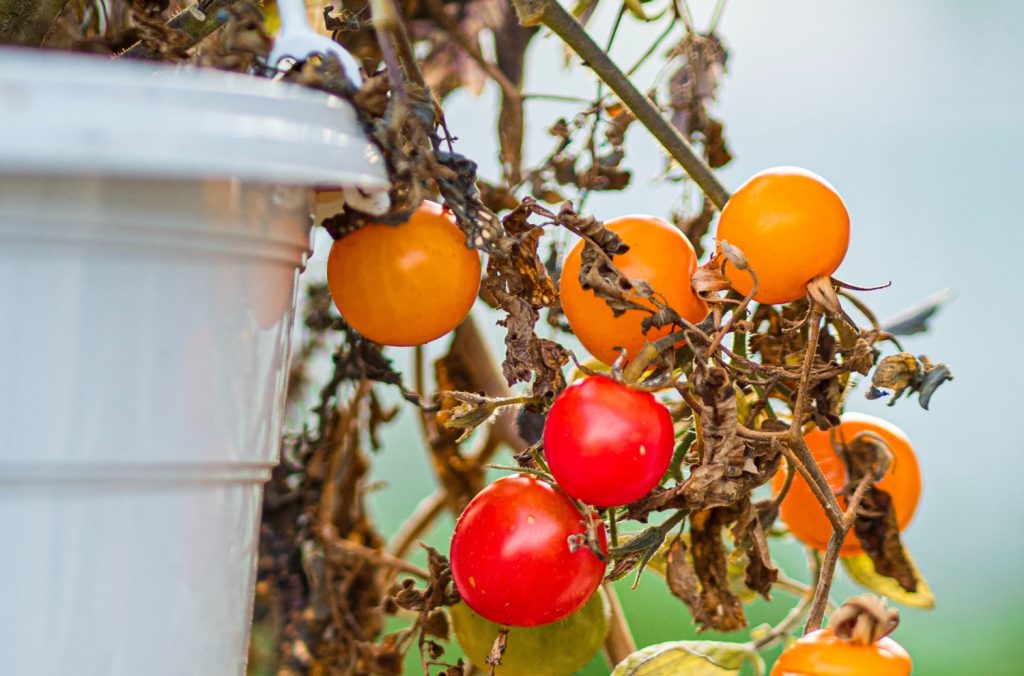
The solution: Soak the soil
If your tomato plants are dehydrated, give them a drink!
Take a soaker hose and place it at the base of your tomato plants. Turn the hose on for half an hour or as long as is necessary to moisten the soil.
If you haven’t got a soaker hose, there’s no need to run out and buy one. Just water your tomato plants well with a regular hose.
Again, a layer of mulch can be helpful. This seals moisture into the soil so you don’t have to water your tomato plants as often.
Whichever type of hose you end up using, it’s important to water your tomato plants deeply, so the moisture reaches the plant’s deepest roots.
Watering the plant’s deepest roots encourages the plants to grow down, rather than out, which helps them stay anchored in place.
That way, if a strong wind comes through, your tomato plants will be less likely to topple over. A trellis or tomato cage can help keep your tomatoes upright as well.
Using a trellis is doubly helpful because it allows you to keep the plant’s foliage up away from the base of the plant. That way, when you water, the leaves won’t accumulate excess moisture, which can make the plants more prone to diseases.
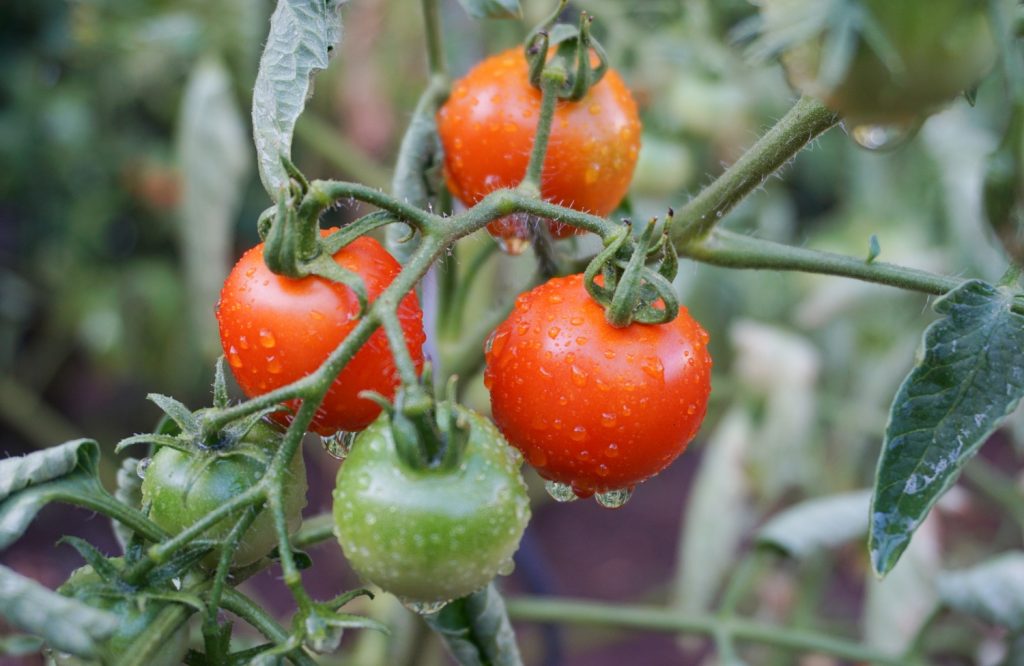
The problem: Overwatering
Too much water can also spell trouble for your tomato plants.
If your tomato crop has been getting too much water recently, then the first thing you’ll notice is yellowing foliage near the base of the plant. Over time, the leaves turn brown and die off.
If the plants have started to produce fruits, the fruits may feel overly squishy and start to rot, or even fall from the stem.
Examine the soil. If you see water standing, then your tomato plants are probably struggling to breathe.
If the soil has been overly moist for a long time, that’s another good indicator that the plants are suffocating. You may even smell rotting foliage.
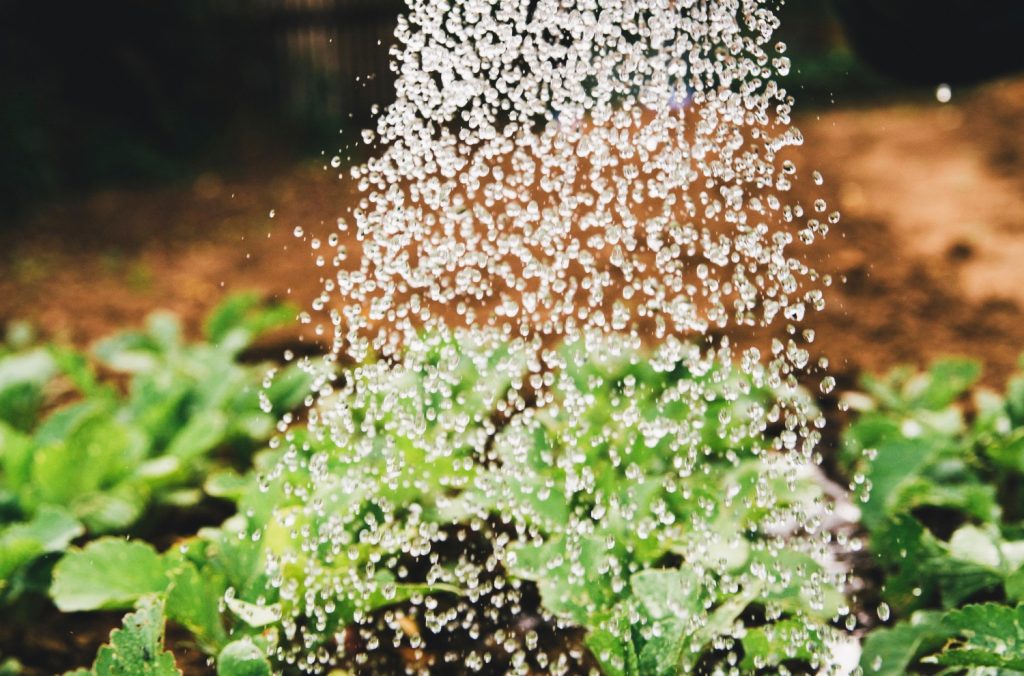
The solution: Improve drainage and cut back on watering
Tomatoes need plenty of water to stay healthy. However, too much moisture can cause your tomato leaves to turn brown.
If your tomato plants have been overwatered, then turn the hose off and allow the plants to dry out thoroughly.
Giving the plants a chance to breathe should help them get back on track. Although the yellow and brown leaves may not recover, their new foliage should be healthy.
You can also improve drainage by amending the soil with some pea gravel and/or horticultural sand.
Use a hand trowel to gently work these materials into the soil without cutting through the plant’s roots.
If water is standing around your tomatoes, you may need to dig a small ditch to help it drain.
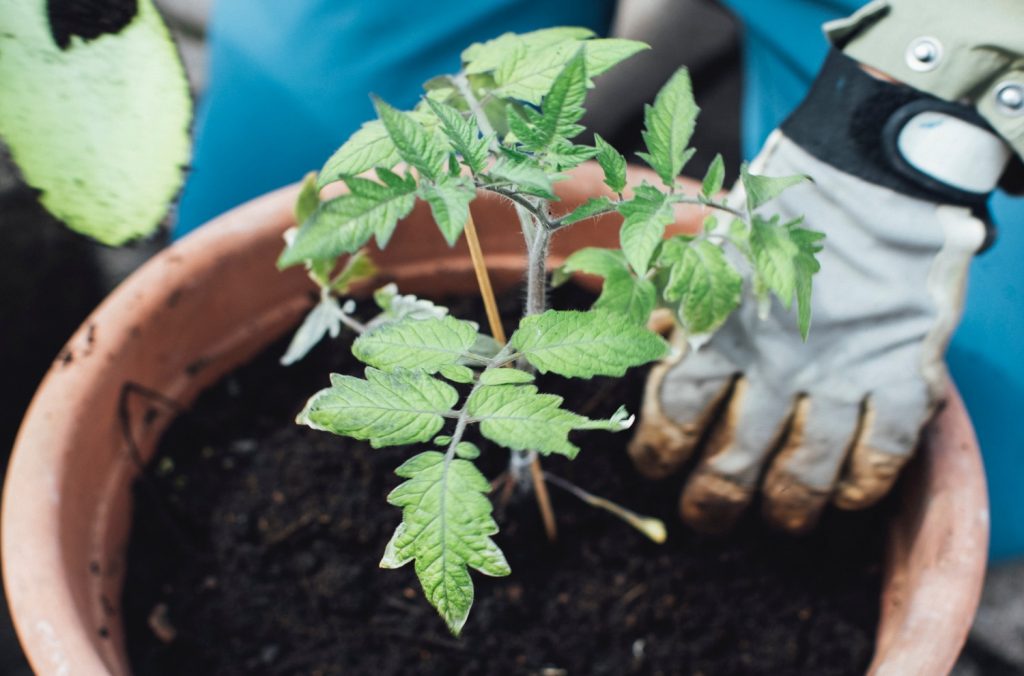
The problem: Disease
Tomatoes are prone to a handful of potentially devastating diseases. Some of these diseases can spread to other nightshade veggies, including peppers and eggplants.
If you suspect your tomatoes are diseased, take a closer look at the foliage.
Discolored leaves with yellow spots in a V-shape are likely infected with Verticillium Wilt. The yellow leaves soon turn brown and fall off.
Bacterial Canker affects the plant’s lower leaves first. The ribs and edges of the leaves turn brown, with the edges turning downward. Eventually, the petiole of the leaf turns brown and it falls away from the plant.
Spread by thrips, Tomato Spotted Wilt results in bronze-brown round lesions on young tomato leaves. The leaves become deformed, as do the fruits, which often fail to ripen.
Early Blight causes brown spots on tomato leaves. These discolored lesions may spread to the fruit, quickly ruining your entire crop.
The first signs of Late Blight are water-soaked spots on the tomato plant’s leaves. The spots are soon covered in white mold, which spreads to the plant’s fruits. Eventually, the foliage turns brown and the plant dries up.
Bacterial Spot is another disease to look out for. Plants develop small water spots that turn brown and leave holes in the foliage. The edges of the leaves turn brown and curl under.
Septoria Leaf Spot causes water spots in the lower leaves of the plant that quickly turn yellow and brown. Septoria Leaf Spot is often the culprit in humid climates, infecting plants during periods of overwatering and/or high rainfall.
The solution: Prune infected leaves and use a fungicide
Unfortunately, some tomato diseases cannot be treated. If your tomatoes are infected with Verticillium Wilt, Bacterial Canker, Late Blight, or Bacterial Leaf Spot, you’ll need to uproot them and destroy them.
But if the disease the plants are suffering from is treatable, and if less than 40% of the tomato plant in question is diseased, then you can help it recover by simply pruning away the infected foliage.
Use sharp garden shears to trim away each leaf, cutting the petiole as close to the main stem as possible.
Prepare a solution of 1 part bleach to 9 parts water and pour it into a spray bottle. Use this to disinfect the shears after every single cut.
Cleaning the shears after each snip is essential to prevent the spread of the infection. After spraying the shears with the bleach solution, wipe them dry with a clean cloth or paper towel.
Adding these branches to your compost heap could spread the disease to future crops, and have deadly consequences for your garden for years to come.
For this reason, you’ll need to be sure to dispose of the diseased foliage properly. Seal the leaves up in plastic bags and throw them away in the trash.
Once your plant has been pruned, spray it down with a fungicide to help prevent and treat the infection. Reapply the fungicide as necessary according to the manufacturer’s instructions on the label.
Now, if 50% or more of the plant is diseased, then it’s going to be a crapshoot.
If you prune them or spray them with fungicides, they may recover, but they may not. The more foliage is affected, the less likely it is that the plant will survive.
If there’s still time left in the season, it may be worth starting new tomato seedlings.
Just be sure not to plant them in the same space that the diseased plants were grown in, otherwise they, too, may become infected.
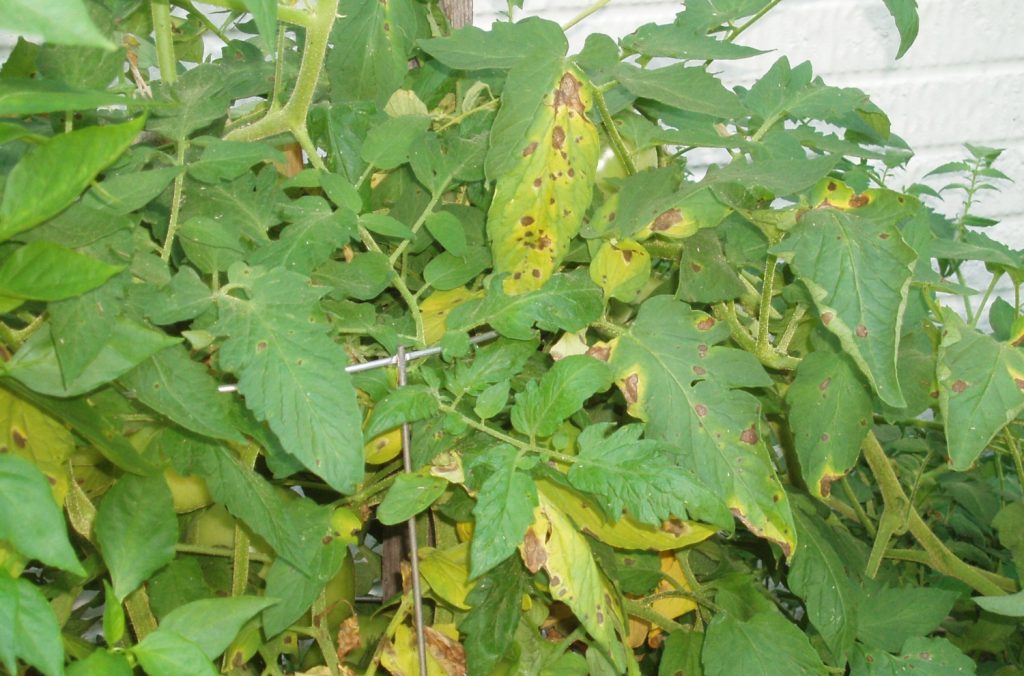
The problem: Pests
Tomato plants produce chemicals that help them ward off pests naturally.
In fact, tomatoes are so good at keeping pests at bay that you can use tomato leaves to create a homemade pesticide.
But even tomatoes can fall prey to insects.
Aphids, spider mites, thrips, grasshoppers, and worms will happily feed on your tomato plants, especially if other food sources are scarce.
Take a closer look at your tomato plants to check for signs of an insect infestation.
You may see chewed leaf margins, holes in the leaves, flowers, and fruits, and sticky, shiny residue on the leaves themselves.
If your tomato leaves are turning brown due to insects, look at the undersides of the leaves.
You may see tiny insect eggs, or even the insects themselves congregating in the shadows.
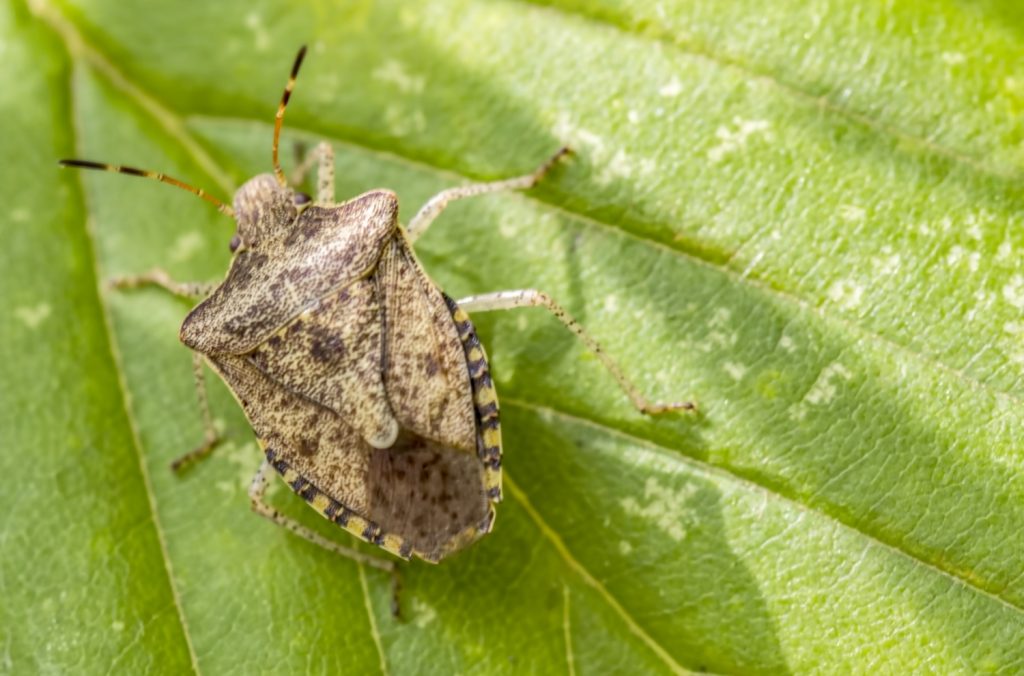
The solution: Apply an insecticide
If you only see signs of insects on a few of your tomato plant’s leaves, remove the leaves and dispose of them.
This will help you get control of the pest population quickly.
Once that’s done, use a hose with a sprayer attachment set to “jet” to physically remove the insects and eggs from the plant. Allow the foliage to dry well, then apply the insecticide of your choice.
Often, an organic homemade pesticide is enough to keep bugs off of your tomato plants.
Just be sure to apply the pesticide regularly to ensure your plants get a chance to recover from the infestation.
Reapply your homemade insecticide every 5 to 7 days, or after rain.
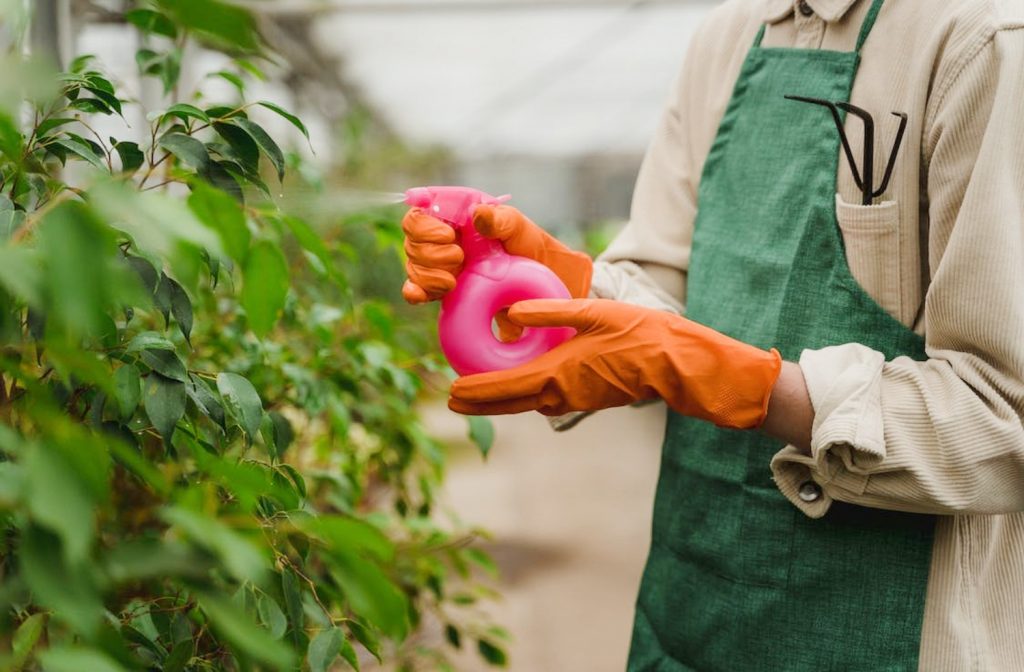
The problem: Nutritional deficiencies
Tomato plants are prolific producers. A single plant can grow more than 100 tomatoes in a single season.
Because tomato plants can produce so many fruits, they have high nutrient needs.
Tomatoes are heavy feeders, and if they don’t get all of the nutrients they need, then not only will they fail to reach their full fruiting potential, but their foliage may also turn brown.
If you’ve noticed your tomato leaves turning brown, test your garden’s soil right away.
Tomatoes are nitrogen lovers, and they’ll quickly develop yellow and brown foliage when soil nitrogen levels are less than ideal.
Plants rely on nitrogen to produce healthy green foliage. And plants rely on healthy green foliage to produce delicious, juicy fruits.
Other signs of nitrogen deficiency in plants include stunted growth, smaller-than-normal new leaves, and failure to flower and fruit.
Of course, nitrogen isn’t the only nutrient that tomatoes need to thrive.
Tomato plants also rely on phosphorus, potassium, calcium, magnesium, and iron to stay healthy. Low levels of any of these nutrients could be contributing to your tomato crop’s browning foliage.
The solution: Apply a fertilizer
If your tomato plants are struggling with low nitrogen levels, then it’s time to feed them.
You can raise soil nitrogen levels quickly by applying a liquid or water-soluble 34-0-0 fertilizer. This is the best option for plants that are showing significant signs of nitrogen deficiency.
You can even apply the liquid fertilizer as a foliar spray to help green up the plant’s leaves.
If your plants are only showing minor signs of nitrogen deficiency, and/or if you would rather take a more organic approach to dealing with this problem, then choose an all-natural source of nitrogen for your tomato crop.
Manure, bat guano, blood meal, and hoof and horn meal are all excellent sources of nitrogen that your tomato plants will benefit from.
These amendments can be added to the soil at the very start of the growing season before you transplant your seedlings to your garden.
This helps the seedlings take root quickly so they get a good start.
Remember to test your soil periodically throughout the growing season to ensure you meet all of your crop’s nutritional demands.
Other soil amendments, like kelp meal, worm castings, and fish fertilizer should also be added. These materials enrich the soil with micronutrients, like calcium, iodine, iron, and magnesium.
Providing your tomato plants with a broad spectrum of vitamins and minerals helps the plants grow vibrant foliage and scads of crisp tomatoes.
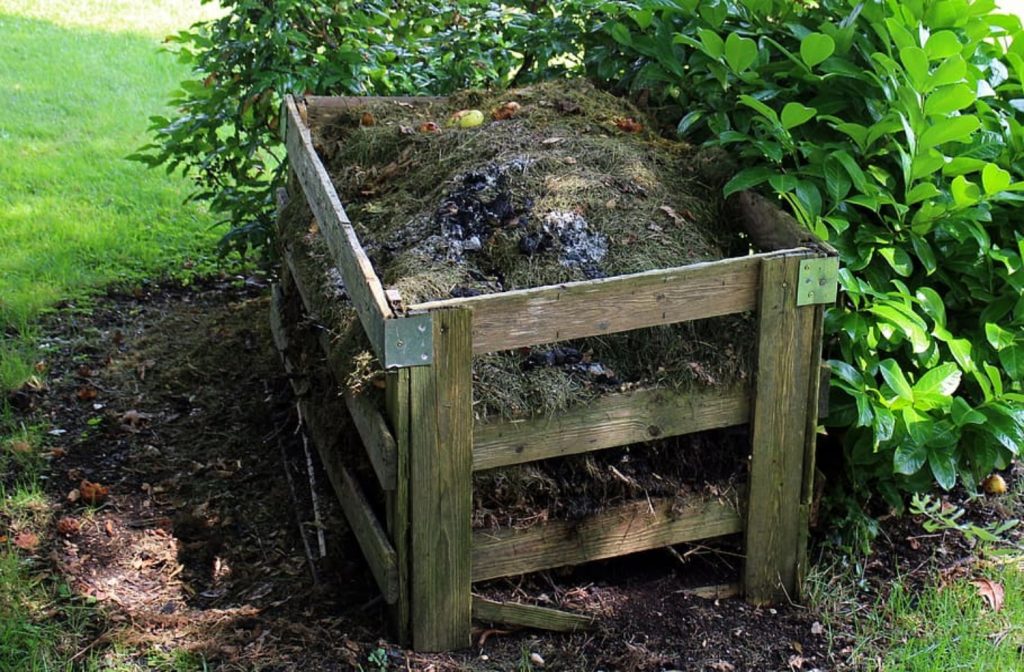
The problem: Overapplication of fertilizer
Tomato plants are heavy feeders, but even they can be overfertilized.
In your quest to ensure your tomato plants stay well-fed, it’s important not to go overboard.
Overfeeding your tomato plants can have fast consequences. If you’ve fed your tomato crop recently and discovered your tomato leaves turning brown, you’ll need to act quickly to save your plants.
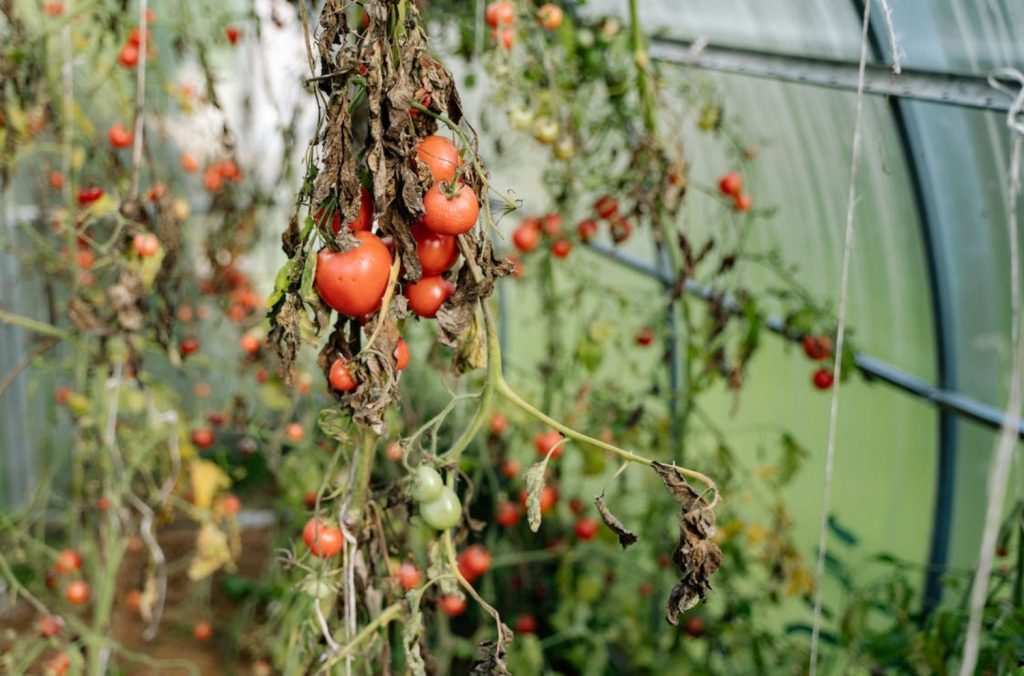
The solution: Water the plants well and scale back on fertilizing
If your tomato leaves are turning brown as a result of overapplication of fertilizer, you can help them recover by watering them deeply. This will flush the excess nutrients out of the soil.
Once the soil has dried out again, do another soil test to see which nutrients, if any, your tomato plants need.
If your tomato plants are already growing in nutrient-rich soil, you may only need to feed them once or twice a season.
Tomato plants need to be fed every 6 to 8 weeks on average. Be sure to stick to a regular fertilizing schedule to avoid overfertilizing your plants and causing your tomato leaves to turn brown.
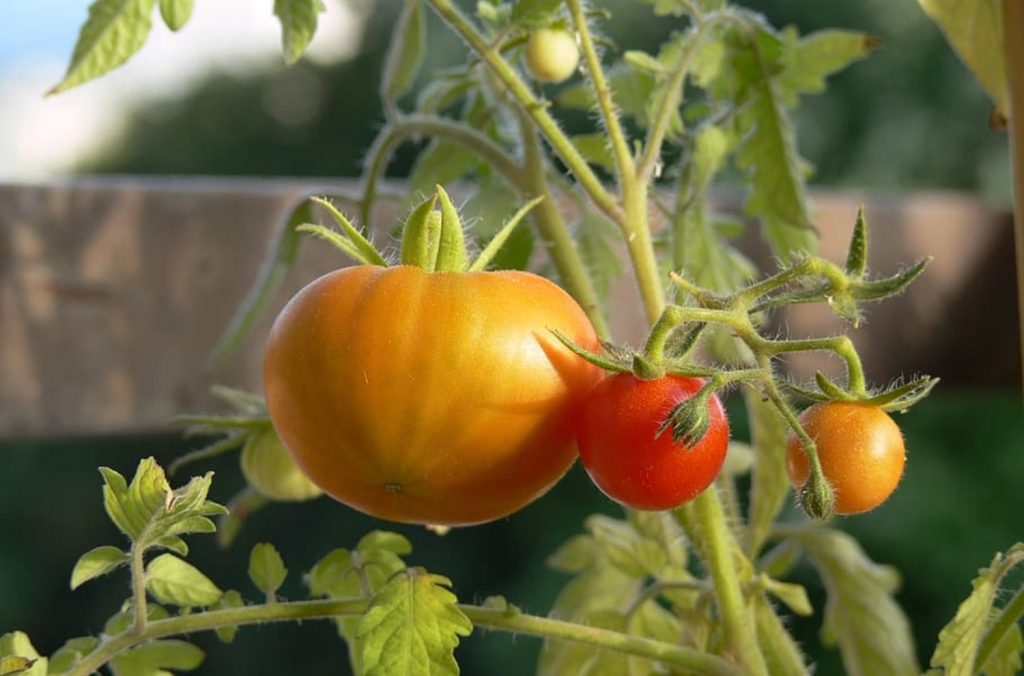
Tips for growing healthy tomato plants
Tomatoes are simple plants. As long as you meet their basic growing requirements, you should have no trouble keeping them healthy.
Start by amending your soil to ensure it has good drainage. Tomatoes grow best in sandy to loamy soil that has a pH of 6.0 to 6.5. Use organic materials, like worm castings, manure, and compost to enrich the soil, and horticultural sand and peat moss to keep it loose and porous.
Water your tomato plants regularly, allowing the soil to dry out completely in between waterings. Use a layer of mulch to insulate the roots.
During periods of extreme heat and/or drought, you should keep the soil uniformly moist, but not sopping wet. This will help the plants stay hydrated and cool.
Use bone meal to feed your tomato plants once they begin flowering and fruiting. This helps prevent blossom-end rot. Test the soil regularly to ensure you meet all of the plant’s nutritional needs.
Lastly, be sure to grow your tomatoes near the right companions. Basil, thyme, borage, and dill are great because they attract beneficial pollinators while also repelling damaging insects that make your tomato leaves turn brown.
With proper care a constant vigilance, you can keep your tomato plants in tip-top shape so they can continue to produce delicious fruits for you and your family to enjoy!
